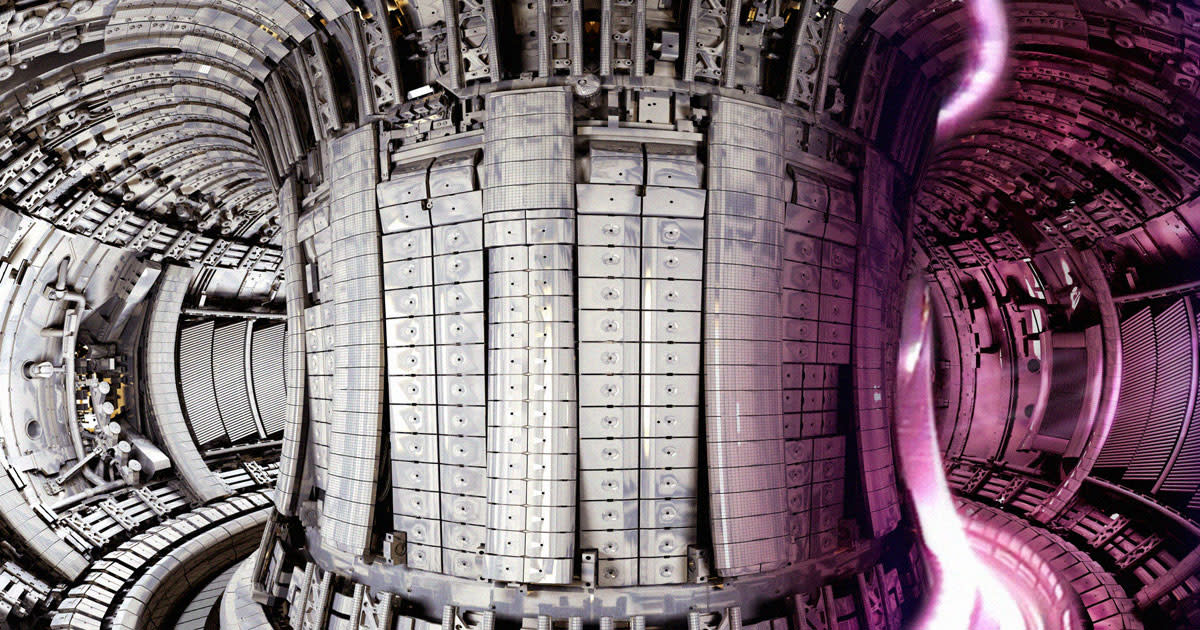Fusion Reactor Produces Record Amount of Energy in Final Experiment

Scientists have set a new fusion energy world record, producing 69 megajoules at the Joint European Torus (JET) in the UK.
The "major scientific achievement" was the lab's final experiment following 40 years of fusion research, a "fitting swansong" per UK minister for nuclear Andrew Bowie.
The facility is a donut-shaped tokamak, a type of fusion reactor that traps a cloud of ultra-hot plasma inside a strong magnetic field.
During its record-breaking run, the JET facility used just 0.2 milligrams of fuel to produce 69 megajoules (12.5 megawatts), which enough to power around 12,000 homes, per New Scientist — though only for five seconds.
On the downside, the record also failed to produce a net positive energy balance, requiring far more energy to be put in to achieve these results. As the Max Planck Institute for Plasma Physics points out, it's "physically impossible" to achieve an "energy gain" with "JET and all other current magnetic fusion experiments worldwide."
Fusion reactors mimic the same processes that power stars, including the Sun. By smashing atoms to bind them together — the reverse of nuclear power reactors, which rip atoms apart — scientists are hoping to generate vast quantities of green energy without the risk of a nuclear meltdown.
But getting to a point where fusion reactors not only generate a net positive energy output, but produce energy at a meaningful scale as well, has been incredibly difficult. Despite many decades of research, we've only recently started achieving the first, and the latter is still likely many years out.
But there are glimmers of hope. The news comes the same week as the publication of a series of papers confirming that the National Ignition Facility achieved a net energy gain in 2022 using the laser-powered reactor at the Lawrence Livermore National Laboratory. The output, however, was comparatively minuscule at 2.5 megajoules of energy, or about enough electricity to boil a kettle.
Scientists are now eagerly awaiting the completion of the International Thermonuclear Experimental Reactor (ITER) in France, the JET facility's much larger and more modern successor.
Researchers are hoping to produce outputs of up to 700 megawatts using the next-gen reactor.
"These are what I usually call power plant scale," Tim Luce, deputy head of the ITER construction project, told reporters during a Thursday briefing, as quoted by New Scientist. "They’re at the lower end of what you would need for an electricity generating facility."
"In addition, we need to extend the timescale to at least 300 seconds for the high fusion power and gain but perhaps as long as an hour in terms of energy production," he added. "So what JET has done is exactly a scale model of what we have to do in the ITER project."
It's not just the US and Europe developing fusion reactors. Last year, China's "artificial Sun," the Experimental Advanced Superconducting Tokamak, reportedly beat its own record, sustaining plasma inside a tokamak for nearly seven minutes.
The Korea Superconducting Tokamak Advanced Research experiment also managed to maintain temperatures north of 100 million degrees Celsius, enough to fuse atoms, for 30 seconds back in 2022.
While the JET facility's latest record is an important step towards establishing a reliable and entirely renewable form of energy, scientists still have a long way to go.
All eyes are now on ITER. Officials are hoping if everything goes according to plan — a big if given the uncertainties involved — a prototype fusion power plant could open its doors by 2050.
More on fusion: Fusion Facility Generates Twice the Power Put Into It

 Yahoo News
Yahoo News 
